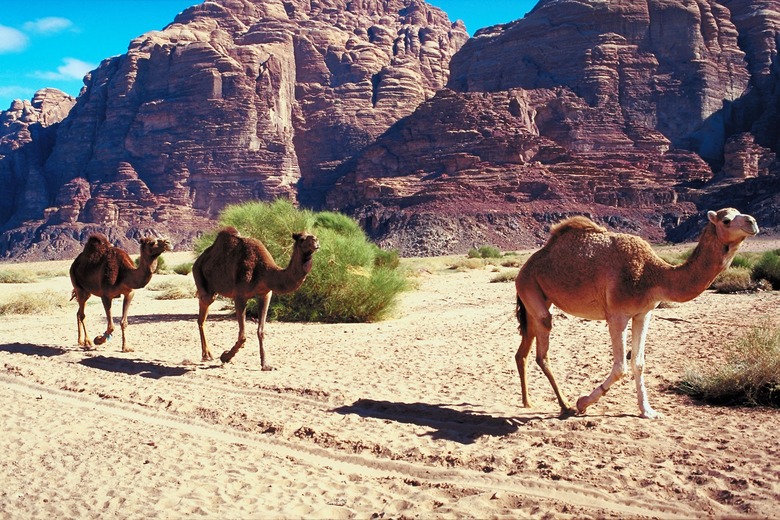What Types Of Adaptations Must Desert Animals Make To Conserve Water?
To a human walking through a desert on a summer day, it seems inconceivable that a rich animal life could exist there. Hot deserts have intense sunlight and maximum temperatures that can reach 43.5 to 49 degrees Celsius (110 to 120 degrees Fahrenheit), limiting free water and causing dehydration. All deserts, hot or cold, exist because humidity is low and rainfall is sparse, with often long stretches between rains.
Desert animals and plants need water for bodily processes and cooling, but animals lose water through breathing, excretion, panting or sweating, and milk and egg production. Adaptations help balance water income and water use, and an animal often exhibits multiple adaptations for survival.
Avoiding the Heat
Avoiding the Heat
A common desert adaptation in animals is to save water by not exposing themselves to hot temperatures. Insects, other invertebrates, rodents, toads, desert tortoises and kit foxes use underground burrows to shelter from surface temperatures that can reach 71 degrees Celsius (160 degrees Fahrenheit). Other refuges include rock crevices and overhangs, caves and the shade from bushes and trees.
Some animals, such as toads, frogs and desert tortoises, escape the heat for months at a time by aestivating in burrows. During aestivation, animals are dormant with reduced breathing and heartbeat, allowing them to escape high heat and conserve water. Most desert biome animals limit their above-ground activity in summer to twilight or evening hours.
Getting Rid of Heat
Getting Rid of Heat
Some desert animals, such as antelope squirrels and camels, are active during hot summer days because they can allow their bodies to accumulate heat without harm. Body temperatures rise to 40 degrees Celsius or more (104 degrees Fahrenheit), doing away with the need to cool themselves by evaporating body water. Squirrels lose excess heat to shaded surfaces and camels to cooler night air.
A variety of adaptation examples can be seen in desert biome animals. Desert sheep, goats, camels and donkeys retain insulating fur on the tops of their bodies but have sparsely covered abdomens and legs that radiate excess heat. Jackrabbits have long legs that carry them well above the heated ground and large ears well-supplied with blood vessels. Blood flow to the ears increases to lose heat to cooler air and flow decreases when air is hotter than body temperature to avoid overheating.
Avoiding Water Loss
Avoiding Water Loss
To save water ordinarily lost in excretion, another common desert adaptation in animals is dry feces and concentrated urine. Specialized desert dwellers, such as the kangaroo rat, have feces five times drier than that of a laboratory rat and urine twice as concentrated as the white laboratory rat. Other animals, including lizards, snakes, insects and birds, excrete uric acid, rather than liquid urine.
Small rodents and birds, such as cactus wrens, have specialized nasal passages that cool the breath before it is exhaled, condensing water for re-absorption. Many desert lizards possess nasal salt glands that excrete potassium and sodium chloride with very little water loss.
Water-Capturing Strategies
Water-Capturing Strategies
Kangaroo rats go their whole lives without drinking free water. They can capture water by oxidizing food — recombining molecules — to create water. One gram of the high-carbohydrate grass seeds that form the bulk of its diet produces one-half gram of oxidation water. Many small desert animals get sufficient water in the food they eat, such as rodents that eat water-storing cactus stems and cactus fruits, and birds that eat insects. The large lizards called Gila monsters store water in fatty deposits in their tails and desert tortoises store water in their urinary bladders that can be reabsorbed when needed.
Desert Plant Adaptations
Desert Plant Adaptations
Desert plant adaptations to conserve moisture include thick, waxy outer coverings and reduced leaves, if there are any leaves. Many desert plants have spines that provide protection from grazing animals and also produce shade. Some desert plant species survive by dying when the environment becomes too dry but leaving seeds with tough outer coatings that protect the seed until the rains come again. To survive, desert herbivores must cope with these plant adaptations.
Cite This Article
MLA
Csanyi, Carolyn. "What Types Of Adaptations Must Desert Animals Make To Conserve Water?" sciencing.com, https://www.sciencing.com/types-adaptations-must-desert-animals-make-conserve-water-10606/. 29 July 2019.
APA
Csanyi, Carolyn. (2019, July 29). What Types Of Adaptations Must Desert Animals Make To Conserve Water?. sciencing.com. Retrieved from https://www.sciencing.com/types-adaptations-must-desert-animals-make-conserve-water-10606/
Chicago
Csanyi, Carolyn. What Types Of Adaptations Must Desert Animals Make To Conserve Water? last modified March 24, 2022. https://www.sciencing.com/types-adaptations-must-desert-animals-make-conserve-water-10606/
